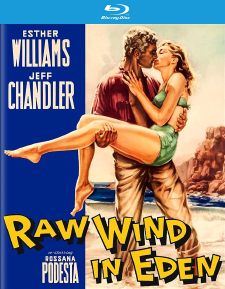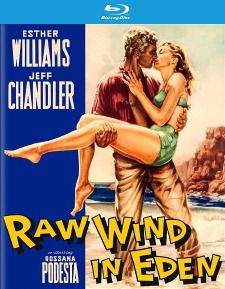Raw Wind in Eden (Blu-ray Review)

Director
Richard WilsonRelease Date(s)
1958 (February 7, 2022)Studio(s)
Universal International (Kino Lorber Studio Classics)- Film/Program Grade: C
- Video Grade: A
- Audio Grade: B+
- Extras Grade: B
Review
Raw Wind in Eden features two attractive leads in a romantic melodrama that uses sex as its lure yet presents a conservative depiction of romance in accordance with 1950s standards.
Laura (Esther Williams, Million Dollar Mermaid) is a bored fashion model on location in Rome for a photo shoot. She plans to spend the weekend with her married millionaire boyfriend but on returning to her apartment, she encounters Wally Drucker (Carlos Thompson, Valley of the Kings), who explains that her boyfriend can’t make it. Displeased, Laura accepts Wally’s invitation to spend the week on the yacht of another wealthy man. Wally will fly her to the location in his private plane.
They never get there. Caught in a storm, the plane crashes on an island off Sardinia populated by only three people: elderly Urbano (Eduardo De Filippo, Ghosts of Rome), his teenage daughter Costanza (Rossana Podesta, Helen of Troy), and a mysterious beachcomber known only as Moore (Jeff Chandler, Female on the Beach). We’ve seen in a pre-credits sequence that the island is periodically visited by a young man (Rik Battaglia, Sodom and Gomorrah) in a small boat who fires a rifle at Moore, with Moore returning fire as the boat retreats. Moore is supposed to marry Costanza the following year, when she’s old enough. The man in the boat had a prior claim to Costanza and feels he must defend his honor.
Much of what follows concerns Laura and Wally’s attempt to get off the island, since a supply ship isn’t scheduled to show up for several weeks. But their distress signal is repeatedly removed and a beached boat is mysteriously sabotaged.
The title of the picture, its advertising, and the setup suggest that plenty of sex is in store, yet the film is quite restrained, more suggestive and titillating than graphic. American films at this time were attempting to compete with more earthy foreign films but the Production Code, although it was beginning to weaken and would dissolve during the next decade, was still an obstacle.
Esther Williams, who had become a star at MGM in a series of aquatic extravaganzas, was lovely as a swimming star in light comedies but shows her weakness as an actress in a dramatic role. She does get to don a bathing suit and take a swim in one sequence but can’t carry a star’s burden of responsibility to make her performance believable. Her line readings lack emotion and often sound disengaged. And for a stranded woman in the middle of nowhere, she’s never less than impeccably made up and coiffed, with a surprising number of costume changes.
Chandler is an actor with an easy-going, laid-back delivery. Though he’s supposed to be eager to marry Costanza, the screen chemistry between him and Podesta is non-existent. What heat does come through is between Chandler and Williams, making the outcome of the plot a foregone conclusion. Chandler has a rugged yet sensual manner, and manages to make the best of a dreary script.
Podesta has a few good scenes but mostly broods in the background as she glares at Williams’ Laura, knowing she presents competition and resenting her interrupting what had been an an idyllic situation on the island. Podesta projects a quiet intensity that communicates jealousy and anger, expressed through her expression and body language.
Director Richard Wilson co-wrote the screenplay with his wife, Elizabeth. It is set up to be a grand-scale soap opera, a specialty of Universal at the time, but can’t overcome cliché upon cliché and a predictable plot with few surprises. What saves the film from being a total write-off is its spectacular scenery, captured in glorious, vibrant color. Think of it as a soap transplanted from an ordinary setting to a paradise, as the title implies.
Raw Wind in Eden was shot by director of photography Enzo Serafin on 35 mm film using the CinemaScope process and finished at the aspect ratio of 2.35:1. Kino Lorber’s Blu-ray release offers breathtaking views of the Mediterranean, its blue-green waters, Williams’ bold costumes, and the island itself, all of which are exquisite. An early sequence shows Laura during her photo shoot, providing an opportunity to show off some extravagant costumes and beautiful backgrounds in Rome. Williams is given the star treatment, with one of her outfits—a red jumpsuit—making her “pop” against the island vegetation. The film serves as a picturesque travelogue at a time when Americans were just beginning to journey overseas in greater numbers.
The soundtrack is English 2.0 mono DTS-HD Master Audio. English subtitles are an available option. Dialogue is clear throughout. Argentinian actor Carlos Thompson was dubbed by Paul Frees, likely because of Thompson’s accent. The sound of the surf splashing on the rocks suggests danger as Laura swims in the strong current. The plane crash occurs off-screen, probably because of budget limitations. A brief shot of a model airplane in flight during the storm represents Laura and Wally’s fateful trip. Gunshots break the peaceful calm of the island in key sequences. Universal’s resident composer Hans J. Salter provided the score, which promises more, musically, than the film delivers.
Bonus materials include the following:
- Audio Commentary by David Del Valle and Daniel Kremer
- Raw Wind in Eden Trailer (2:21)
- The Unguarded Moment Trailer (2:24)
- Female on the Beach Trailer (2:25)
- Foxfire Trailer (2:17)
- Man in the Shadow Trailer (2:17)
- Ten Seconds to Hell Trailer (2:15)
In their audio commentary, film historian David Del Valle and filmmaker Daniel Kremer spend a good deal of time discussing the film’s lush photography, saying it’s “stunning to look at.” They note that the Kino Lorber Blu-ray is the first video release ever of the film. They believe the role of Laura would have been more suitable for Joan Collins. People tend to recall the film as a guilty pleasure. Esther Williams found herself at a new studio because “Universal was the go-to place when MGM stars lost their contracts.” Many of the people who worked on Raw Wind in Eden were associated at one time with Orson Welles. Carlos Thompson was often cast as a European womanizer. Eduardo De Felippo was revered in Italy as a writer and was given special, single-card billing. John Gavin was originally cast as Moore, but leading men at Universal at the time were interchangeable and Jeff Chandler was ultimately selected for the role. Raw Wind in Eden reflects the sexual puritanism of the 1950s. The film’s budget was impressive. In that era, studios created a scenario and hoped the public would like it. Today, it’s all about demographic research. Esther Williams’ acting style is compared to that of Doris Day. Williams had appeared on TV as a guest star on various shows and was the star of a TV “spectacular” filmed at Cypress Gardens. Jeff Chandler was well liked and easy to work with. Referring to the film’s brief running time, the commentators note, “We live in a time when no one knows how to make a 90-minute movie.”
Raw Wind in Eden is a kind of time capsule, representing an awkward transitional period in Hollywood’s depiction of adult relationships. Movies were trying to appeal more to changing tastes and the public’s desire for more than routine romantic films. The studios knew how to light the embers of male-female relations but were still unable to create real fire.
- Dennis Seuling

